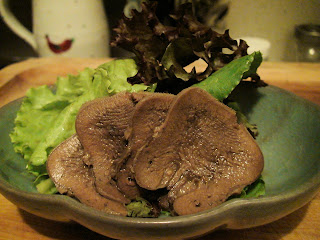What's Wrong with my Tongue?
I ate a plate of beef tongue recently at Tsukushi, a small Japanese restaurant in midtown. It was part of long lineup of dishes that the chef served to us, and it was one of the best things I've eaten in recent memory. The meat was sliced into very thin, perfectly round circles, and served warm on a bed of fresh greens. It was moist, as if it had been swirled in its cooking juices right before serving. The taste was definitely beefy but in a gentle way, and the texture was a miracle of melt-in-your-mouth silkiness.
So when I saw a Slope Farms beef tongue the following week at the Food Coop, I had to try making this at home. And by the way, it's not easy to find a Slope Farms beef tongue. Slope Farms sells only the whole animal - no parts, so the Coop gets one tongue every week or two. There are 13,000 members of the Coop, and all of them are always on the lookout for the tongue. Okay, even if it's only 10% of them, that's over 100 people I'm jockeying with.

The next evening I reduced some of the strained and skimmed cooking liquid, seasoned with salt and a bit more sherry vinegar, and swirled some thin slices of tongue. Tossed some fresh lettuces in the same cooking liquid, and finished with a few drops of sesame oil and a bit more salt.
Some of you know how to cook tongue - so tell me, what went wrong with my tongue?







7 comments:
"Silkiness" makes me think he just cooked it longer without the membrane, which might act like silverskin. I generally make lambs' tongue over calf/beef, but I always parboil them first to remove the membrane before introducing them to a longer simmer in stock or ragu.
Perfectly round makes me think it was tied while the silky leads me down the immersion circulator path. hours of cooking at precise, low temperatures. seems like this might be impossible to recreate without the proper equipment. The burning question is did you drink anything with this?
I've Sous-Vide tongue at home before and the middle part where the fat is is soft and melt in your mouth but I found the tip gross. I did peel it before hand tho
Per Keller's "Under Pressure":
Brine for 28 days at 55F.
Cook sous vide for 24 hours at 158F.
Then peel it and slice.
I've never tried it and I doubt I would given the long brine and the sous vide requires the tongue to be accuum packed with brine.
Hi Neil,
We are big tongue fans. A lot of people have a bit of trouble with the idea, find it a bit to.....well personal when it comes out of the pot. But the idea of a warm sliced tongue sandwich on rye gives some people that far away comfort food look. Having it be part of your childhood foodscape helps.
Anyway……we pickle the tongue in brine before cooking it. Here's a pickling recipe http://www.wasabibratwurst.com/pickled-tongue/. Which of course we don't quite follow.
I do the week long brining, but use less water (tap water is fine in NYC, thanks to us up here in the watershed keeping our cattle out of the streams) and proportionately less salt. And even less than proportionate suger. I also use pickling spice from our local co-op rather than the spice mix. And no saltpeter! After a week I rinse it off. And then place the tongue in fresh water with a bay leaf. We don’t use the veggies in this recipe which makes it taste too much like chicken in chicken soup. Simmer, not boil, for 2-3 hours until fork tender. After removing from the water (which will make an amazing stock diluted for a bean-veggie soup) let cool for a few minutes, while you think about the animal from which it came (and hopefully give thanks). You can then peel off the thick skin, mostly using your hands. Slice the tongue, and eat on rye bread with mustard. Warm up left over’s and do the same.
Ken Jaffe
Slope Farms
slopefarms.com
i cannot say this for sure, but I doubt that the chef at Tsukushi uses sous vide technique. Could be wrong though. The long brining some of you recommend sounds like it would make for incredibly render meat. Doesn't it impart a briny flavor though?
We drank an interesting wine with this, but I didn't have time to write about it. It was a 1985 Mas de Daumas Gassac and it, confusingly, was tired and lifeless, although it was stored well and in great shape.
Instead of brining, you could try a dry cure. Rub it all over with salt, maybe a bit of sugar, and herbs and spices that match your intended finished dish. Leave it in the fridge for a few days, then rinse it off. Blanch and peel the tongue, then tie it, then poach it as gently as you can for as long as you can (without a water bath). If you put a big pot on your lowest burner with a thermometer in it, you can get pretty accurate results. If you don't want to deal with the bag, I'd poach it in some stock and aromatics and then reduce that for a sauce.
Post a Comment